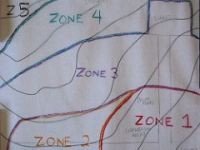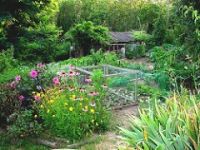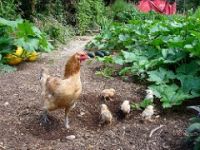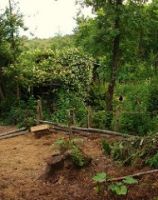A Guide to Zoning Your Permaculture Garden

The idea when working out the position of different elements in your outside space is to begin at your home and work outwards. Those areas that you will need to visit and interact with most frequently should be positioned closest to your home, while those that are left most to their own devices should be furthest away. This may seem obvious, but it is surprising how often this principle is ignored. Often, the most productive vegetable garden areas are hidden away right at the end of a garden. Putting these areas closer, where you can tend them and keep an eye on them more easily will make things far easier.
 Your home, in a permaculture system, is designated as Zone Zero. This is the epicentre of operations. From here, the zones will spread out one after another. In a domestic, urban garden there will often only be two zones, while in larger gardens, smallholdings and small farms, you may have zones one to five. Here is a brief idea of what you might expect to include in each of the zones:
Your home, in a permaculture system, is designated as Zone Zero. This is the epicentre of operations. From here, the zones will spread out one after another. In a domestic, urban garden there will often only be two zones, while in larger gardens, smallholdings and small farms, you may have zones one to five. Here is a brief idea of what you might expect to include in each of the zones:

Zone One: Intensive annual vegetable growing areas, herb gardens, worm composting, rainwater harvesting, greenhouse or polytunnel, perhaps a frequently utilised shed.
Zone Two: Longer term/perennial vegetable beds, fruit gardens/ orchard, compost bins or heap, garden pond, perhaps chickens or bee hives.
Zone Three: Farmland crops and areas for larger livestock.
 Zone Four: Part managed areas of pasture/ forage/ timber production.
Zone Four: Part managed areas of pasture/ forage/ timber production.
Zone Five: Untamed wilderness zones.
The zones are not meant to be visualised as hard-edged boundaries, nor should they be thought about as strictly concentric. As well as thinking about which zone elements should be in, it is also important to think about the systemic interaction between the various elements. While generally speaking zone one will be closest to your home, other zones may sometimes come closer – for example, you might have a zone five wildlife corridor that comes close to the back of your home. It is also important to think about the constraints and conditions where you live, as other practical considerations may come into play.
There are no hard and fast rules when it comes to what should be placed where in a permaculture garden, but thinking about zoning and the interaction between elements should help you to create a system that is efficient and sustainable – less work for the gardener and more benefit to your eco-friendly way of life.